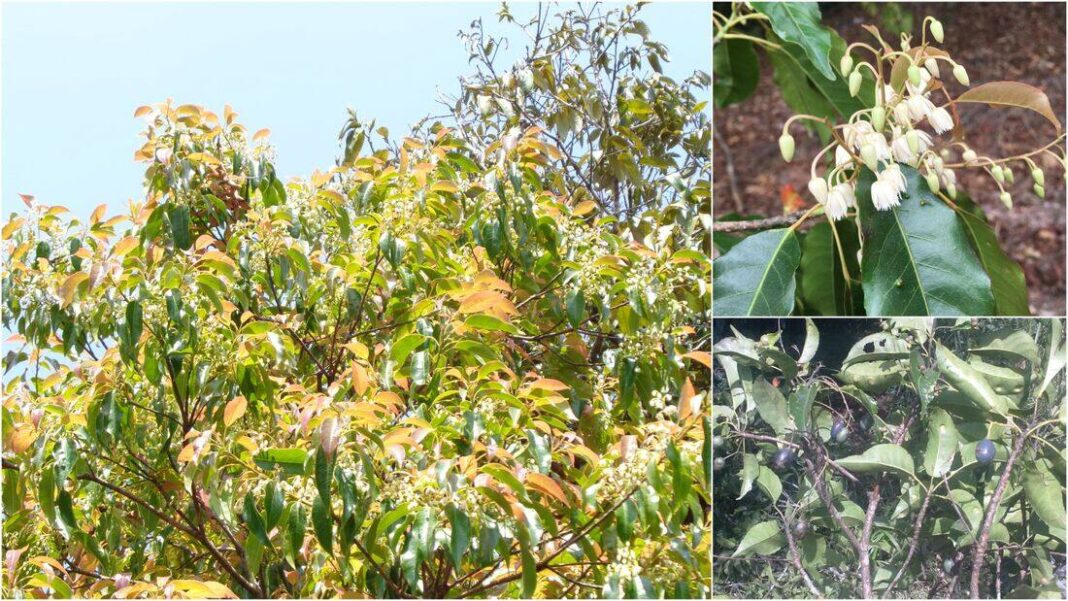Shillong, April 9: Scientists have used machine learning, a subset of artificial intelligence to help save Elaeocarpus prunifolius, a rare tree species found in Meghalaya. A new study has identified the best places for its conservation, offering hope for its survival.
The research, published in Modeling Earth Systems and Environment, used machine learning to map out where the tree can grow. Scientists found that around 8.97% of Meghalaya’s land—about 201,321 hectares—is suitable for E. prunifolius. Most of these areas are in the Khasi and Jaintia Hills.
The study was done by Viheno Iralu, Dibyendu Adhikari, Krishna Upadhaya and Hiranjit Choudhury.
“Recent advancements in remote sensing and geospatial technologies have significantly enhanced the ability to monitor forest landscapes. Ecological niche modeling (ENM) has emerged as a powerful tool for estimating species distributions by correlating occurrence records with environmental variables to predict potential distribution areas within an ecological context. These models are instrumental in narrowing down potential habitats, optimizing field surveys that would otherwise be resource-intensive and logistically demanding” the study says.
Of the 8.97% (≈201,321 ha) suitable potentially suitable for E. prunifolius, 0.10% is classified as very high potential, 0.97% as high potential, 2.48% as medium potential and 5.42% as low potential.

Despite having suitable habitats, E. prunifolius is struggling to survive. Deforestation, farming, and human settlements are destroying its natural home. The study found that logging for timber and land clearing for agriculture have drastically reduced its population.
Even in protected areas, the tree faces other challenges. Its seeds fall too early, and many are eaten by rodents and insects before they can sprout. “Human activity and natural threats are making it difficult for this species to regenerate,” the researchers noted.
Between 2014 and 2018, scientists conducted field surveys in 43 locations. They found only 275 adult trees, along with 828 saplings and 1,252 seedlings. While some areas had healthy tree populations, many showed little to no natural regrowth
The study also revealed an interesting pattern: the tree isn’t always found in the biggest forests. However, areas with more saplings and seedlings were mostly in larger, undisturbed forests, suggesting these places still offer hope for the species.

The sites for reintroduction of the species have been suggested in the following sites namely Lum Shynna, Lawbah Arliang, Sai Mika forest, Tyllong UmKyrwiang, Wah Bah Pomolang, Law Shnong Umladkur 3, Law Shnong Umladkur 7, Krang Suri forest, Law Shnong Umladkur 4, Law Siarpa, Law Syiem Ramakrishna Mission and Law Shnong Amlarem.
The researchers recommend urgent conservation efforts. They have identified key areas, especially in the East Khasi Hills, where around 10,361 hectares are perfect for growing E. prunifolius. The scientists suggest protecting these high-suitability zones, creating seed banks to preserve the species, setting up tree nurseries for replanting efforts and stricter rules to prevent deforestation for conservation of Elaeocarpus prunifolius.
Also Read: NEHU student bodies demand Prof Sungoh’s resignation as Pro VC over alleged irregular appointment
Also Watch
Find latest news from every corner of Northeast India at hubnetwork.in, your online source for breaking news, video coverage.
Also, Follow us on-
Twitter-twitter.com/nemediahub
Youtube channel- www.youtube.com/@NortheastMediaHub2020
Instagram- www.instagram.com/ne_media_hub
Download our app from playstore – Northeast Media Hub





